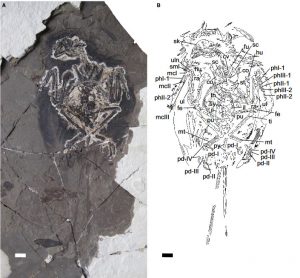
Scientists have recently discovered a new bohaiornithid bird specimen from the Early Cretaceous Period of China with remarkably preserved feathers. Bohaiornithid birds belonged to enantiornithes, a group of avian dinosaurs that lived millions of years ago.
Our current knowledge of prehistoric plumage is limited, but the new findings provide valuable insights related to structure and colouration.
“Many enantiornithine birds possessed ornate feathers. This new specimen shows that some enantiornithines also had iridescent feathers and unlike most modern birds, these flashy ornaments developed before the animal was fully grown,” said Jennifer Peteya, lead author of the Palaentology study.
Reference:
The plumage and colouration of an enantiornithine bird from the early cretaceous of china. DOI: 10.1111/pala.12270
Note: The above post is reprinted from materials provided by Wiley.










